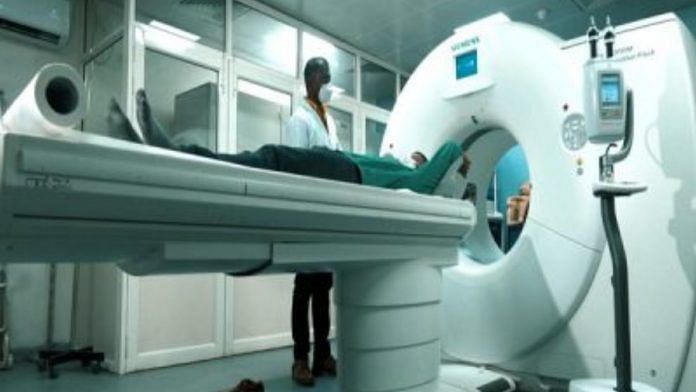To achieve the Sustainable Development Goals and targets of universal health coverage, the Indian government has expended significant efforts to promote the digitisation of the healthcare sector to make health accessible, affordable, and equitably distributed.
On 27 September, 2021, Prime Minister Narendra Modi announced the rollout of the Ayushman Bharat Digital Mission with the aim of integrating the different and disparate digital health systems that exist into a National Digital Health Ecosystem.
The ABDM currently has five main components: 1) Ayushman Bharat Health Account (ABHA) number – A unique health identification number, 2) Healthcare Professionals Registry (HPR)–A repository of healthcare professionals across both modern and traditional systems of medicine, 3) Health Facility Registry (HFR)–A repository of both public and private health facilities, including hospitals, clinics, diagnostic laboratories, and pharmacies, 4) Unified Health Interface (UHI)–an open protocol for digital health services linking patients with healthcare providers, 5) ABHA Mobile App–An app allowing an individual to carry electronic health records.
Also read: Green superpower: India must leverage its startup ecosystem for its net-zero transition
Mixed healthcare system
The two registries would ostensibly create a database of India’s healthcare institutions and professionals that citizens would be able to access. The ABHA number and the application allow citizens to securely identify themselves and carry their health records to any healthcare facility. And lastly, the UHI would facilitate greater access to and delivery of healthcare services. All of this activity has and will generate a tremendous quantity of data, which will be crucial for research, innovation, and policymaking.
All citizens, healthcare facilities or institutions, and healthcare professionals can choose whether they will participate in the ABDM.
India has a mixed healthcare system, which means that it has both public and private healthcare providers. Without significant participation from the private healthcare providers, the ABDM’s ability to achieve its objectives will be limited. This is because private healthcare infrastructure accounts for nearly 62 per cent of all of India’s health infrastructure and the private sector also provides 81 per cent of the doctors in India.
There is also a drastic difference in the accessibility of healthcare services based on whether the population is rural or urban. The urban population which is about 28 per cent of India’s total population have access to 66 per cent of the total hospital beds. Despite this, both rural and urban population in India seem to prefer seeking treatment from the private sector. Only 33 per cent of the rural and 26 per cent of the urban population depend on the public sector for healthcare.
The voluntary nature of participation in the ABDM has led to a significant portion of private healthcare providers opting to not participate in the universal programme nor integrate into the UHI. Smaller healthcare providers like charitable hospitals, clinics, diagnostic labs, pharmacies, or nursing homes are less inclined to participate because of the significant costs involved. First, the cost to these healthcare providers, who are most likely in various stages of digitisation, is the number of man hours required to digitise their health records and other data. Second is the actual financial cost of upgrading or altering their digital health systems to meet basic required standards to participate in the ABDM and the UHI.
Also read: Indian space tech should now build small satellites, forge big global partnerships
Impact of non-participation
In contrast, larger entities like Apollo Hospitals and Fortis group’s SRL Labs seem to have been more inclined to participate in the ABDM and integrate into the UHI. They have already digitised records and developed digital health systems that meet the required standards. It also gives them the opportunity to provide their already existing tele-health and tele-consulting services to a wider segment of the population. Health start-ups are also more likely to participate because they will benefit from providing services via an open protocol, like the UHI, without incurring the costs that healthcare providers would.
A lack of participation from the private sector will negatively impact the objectives of the ABDM in two major ways. Considering the concentration of private healthcare providers in urban areas, a lack of their participation and integration would limit the UHI’s ability to bring previously inaccessible services to the rural population who would otherwise have to travel to access them. Second, the data generated by the ABDM and use of the UHI would be incomplete, which in turn would significantly limit the effectiveness of policy planning and programme delivery.
The National Health Authority, which is responsible for the ABDM and the UHI, appears to be cognizant of the challenge it faces in getting the private sector to participate. One of the stated objectives of the ABDM is “to ensure that the healthcare institutions and professionals in the private sector participate actively with public health authorities in the building of the ABDM, through a combination of prescription and promotion”.
It is unclear whether the government intends to achieve private sector participation through incentives or mandates. Without either approach, it seems that the ABDM will see little participation from smaller private healthcare providers, though how this will play out remains to be seen.
Arjun Kang Joseph is a senior research analyst with Carnegie India’s Technology and Society Program and co-convenor of the Global Technology Summit.
The article is part of a series examining the geopolitics of technology, which is the theme of Carnegie India’s seventh Global Technology Summit (29 November to 1 December), co-hosted with the Ministry of External Affairs. Click here to register. ThePrint is the digital partner. Read all articles here.
(Edited by Tarannum Khan)



